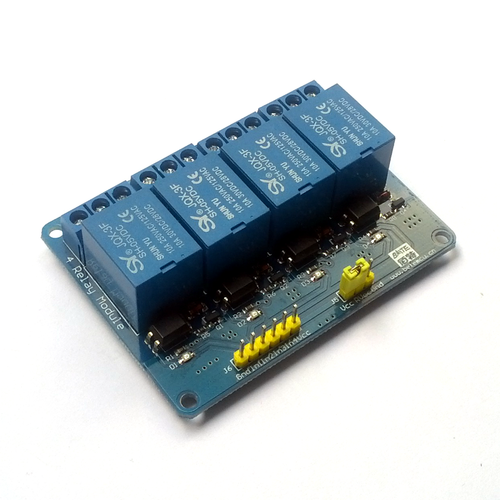
4-channel, 5V relay module with optocoupler
A relay can be used to control a large current device from your microcontroller/microcomputer (Raspberry Pi, Beaglebone Black, Arduino, PIC etc.).
This board has 4 active-low relays with each has a status indicator LED, an input pin to control the relay and three terminals (normally open, normally closed and common terminal). Each relay is also opto-isolated. This means, there is no electrical connection between the high voltage device and the low voltage circuit that switching the relay. Therefore, it is much more safe and reduce the chances of accidently destroying the microcontroller that controlling the relay.
There are 2 sets of headers. The first set is 6-pin headers for triggering the relays. They are indicated on the PCB as In1, In2, In3 and In4 for input pins of each relay and Gnd and Vcc pins. Vcc is the module's voltage which gives logic HIGH. You can connect this to the 3.3V/5V voltage source from your microcontroller/microprocessor. The input pins (In1-4) are to be connected to signal pin of your microcontroller/microprocessor. The relay is triggered when the input pin gets LOW signal.
The second set of headers has 3 pins for driving the relays. They are marked as Vcc, RVcc and Gnd. The RVcc pin is for the relay coil voltage. The board ships with a jumper over Vcc and RVcc pins, shorting those two to give the same voltage for signalling and driving the relays. Effectively, the relay is powered by the 5V source of your microcontroller.
The relays can also be powered externally if your found out that your microcontroller do not have enough current or if you want to have an isolation between the relay signal and power circuit. To use external voltage source, remove the jumper and connect external 5V to the RVcc and GND.
Warning: Mains electricity can kill you. Please consult with a licensed electrician if you are working with the mains!
Features:
- 5V 4-channel relay board with optocoupler, each needs 15-20mA driver current
- SPDT type relay with one normally open terminal, one normally closed terminal and one common terminal
- Standard 2.54mm input header that can be controlled directly by microcontroller/microprocessor TTL logic (Raspberry Pi, BeagleBone Black, Arduino etc.)
- Screw terminals for relay contact
- 5V relay input signal voltage (Range: 0-5V)
- LOW on input pin will switch the relay
- Vcc is module voltage, RVcc is relay voltage. Vcc and RVcc are shorted by a jumper by default
- Relay contact capacity: 250V AC 10A or 30V DC 10A
- LED for state indicator for each relay
- Board dimension: 53 mm x 70 mm
- Mounting holes on the 4 corners of the board
